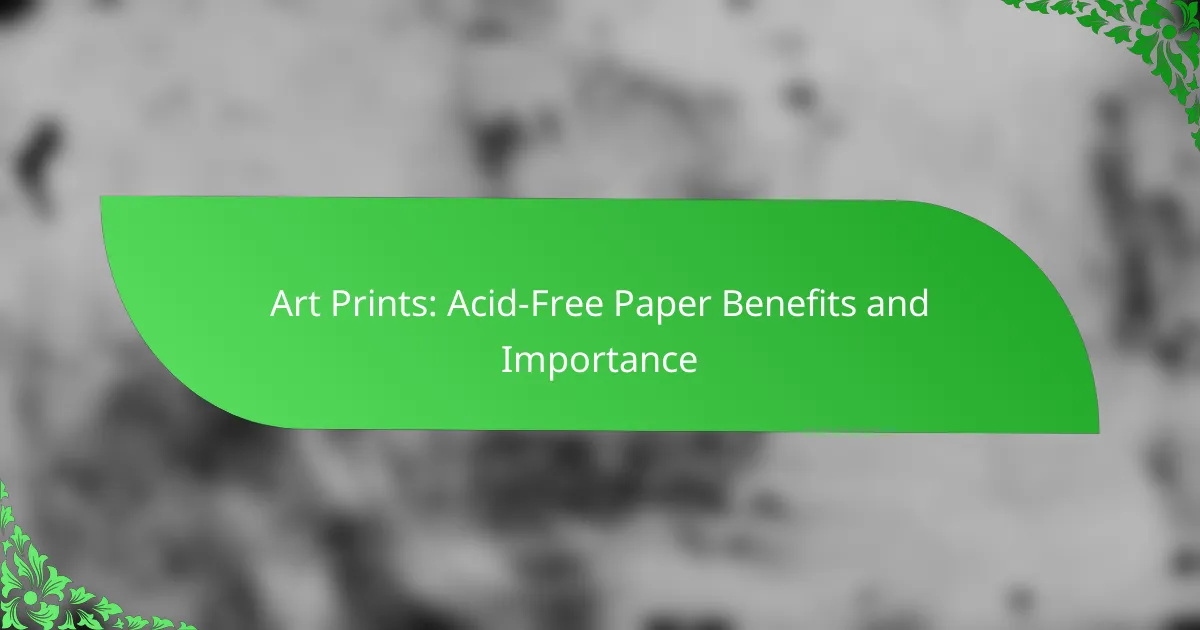Using acid-free paper for art prints is essential for preserving the quality and vibrancy of the artwork over time. Unlike regular paper, which can deteriorate and cause yellowing due to acidity, acid-free options ensure that prints remain intact and visually appealing for longer periods. With various types available, including fine art paper and photo paper, artists can choose the best option to meet their specific needs and enhance the longevity of their creations.

What are the benefits of using acid-free paper for art prints?
Using acid-free paper for art prints offers significant advantages, primarily in preserving the quality and appearance of the artwork. Acid-free paper prevents damage caused by acidity, ensuring that prints remain vibrant and intact for longer periods.
Prevents yellowing and deterioration
Acid-free paper is specifically designed to resist the chemical reactions that lead to yellowing and deterioration over time. Regular paper contains acids that can break down fibers, causing discoloration and weakening the material. By choosing acid-free options, artists can ensure their prints maintain a fresh appearance for decades.
Enhances longevity of artwork
The longevity of artwork is greatly enhanced when printed on acid-free paper. This type of paper is less prone to environmental damage, such as humidity and light exposure, which can accelerate degradation. As a result, art prints on acid-free paper can last significantly longer than those on standard paper, often exceeding fifty years with proper care.
Maintains color integrity over time
Acid-free paper helps maintain the color integrity of prints, preventing fading and color shifts that can occur with acidic materials. The neutral pH of acid-free paper ensures that inks and pigments remain stable, allowing colors to stay true and vibrant. This is particularly important for artists who want their work to be displayed without losing its original impact.
Supports archival quality standards
Using acid-free paper aligns with archival quality standards, which are essential for preserving artwork in museums and galleries. Many professional artists and institutions require acid-free materials to ensure that their collections remain in excellent condition. By adhering to these standards, artists can increase the value and longevity of their work, making it more appealing to collectors and institutions alike.
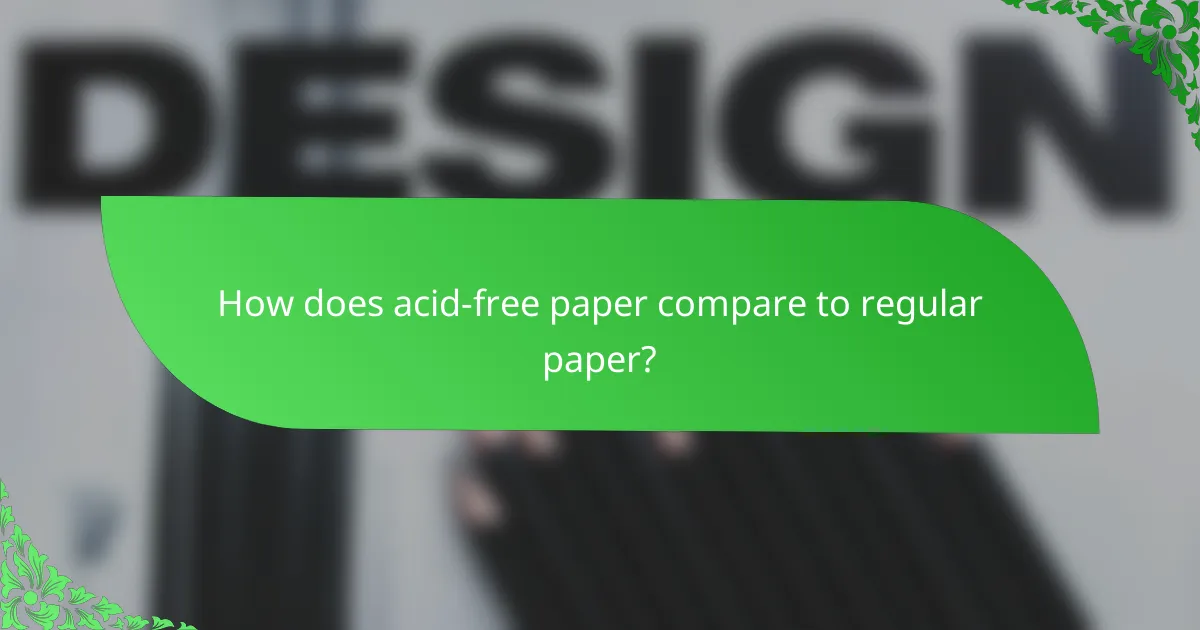
How does acid-free paper compare to regular paper?
Acid-free paper is designed to resist deterioration over time, making it a superior choice for art prints compared to regular paper. Regular paper contains acids that can cause yellowing and brittleness, while acid-free options maintain their integrity for longer periods.
Lower acidity levels
Acid-free paper has a pH level of 7 or higher, meaning it is neutral or alkaline. In contrast, regular paper often has a pH below 7, which leads to the breakdown of fibers and degradation of the print. This lower acidity in regular paper can result in visible damage within a few years.
For art prints, using acid-free paper helps preserve the vibrancy of colors and prevents fading, ensuring that the artwork remains in pristine condition for decades.
Better resistance to environmental factors
Acid-free paper is more resistant to environmental factors such as humidity and temperature fluctuations. This durability is crucial for art prints displayed in varying conditions, as regular paper may warp or degrade when exposed to moisture or heat.
Additionally, acid-free paper is less prone to attracting mold and mildew, which can be particularly important in humid climates. This resistance helps maintain the quality and longevity of the artwork.
Different cost implications
Acid-free paper typically costs more than regular paper due to its specialized manufacturing process. Prices can vary widely, but acid-free options may be 20-50% more expensive than standard paper. However, the investment is often justified by the increased lifespan and preservation of the artwork.
When budgeting for art prints, consider the long-term benefits of acid-free paper. While the initial cost is higher, the reduced need for replacements and restorations can lead to savings over time.
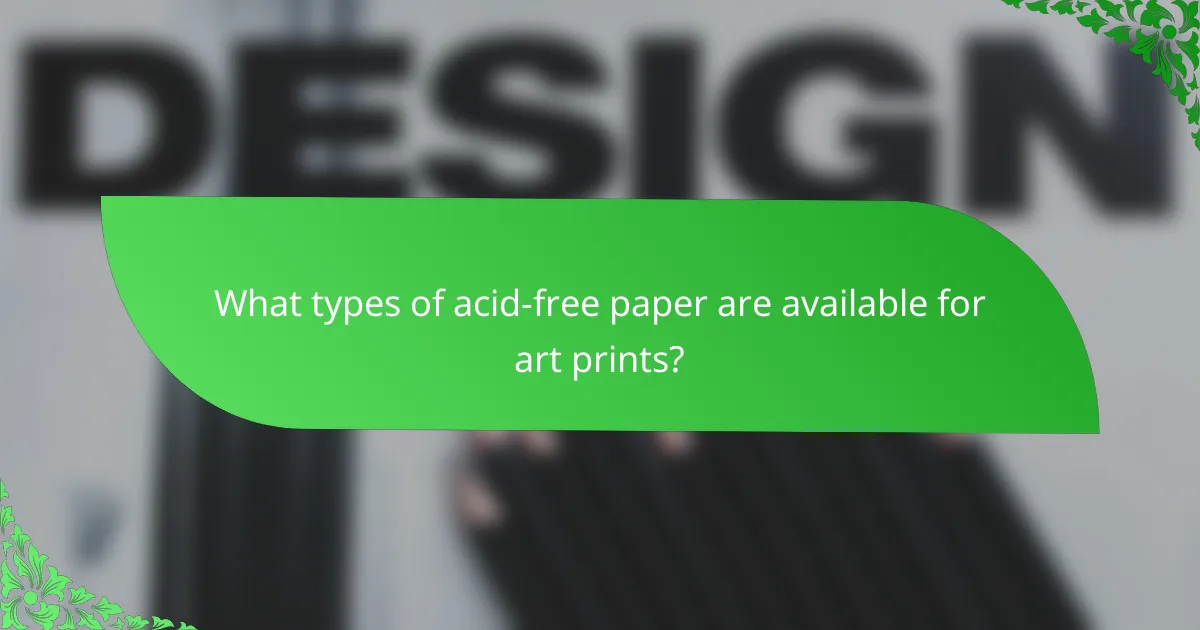
What types of acid-free paper are available for art prints?
Acid-free paper for art prints comes in various types, each suited for different artistic needs and preferences. The main categories include fine art paper, photo paper, and cardstock, each offering unique characteristics that impact print quality and longevity.
Fine art paper options
Fine art paper is designed for high-quality reproductions and is often made from cotton or alpha-cellulose. These papers typically have a textured surface that enhances the visual appeal of prints, making them ideal for artworks that require a tactile finish.
When selecting fine art paper, consider the weight and thickness, which usually range from 190 to 400 gsm. Heavier papers tend to provide better durability and a more substantial feel, which can enhance the overall presentation of the artwork.
Photo paper varieties
Photo paper is specifically formulated for photographic prints and is available in glossy, satin, and matte finishes. Glossy photo paper enhances color vibrancy and sharpness, while matte finishes reduce glare and provide a more subdued look.
For acid-free photo paper, look for options that are labeled as archival quality, which ensures longevity and resistance to fading. Weights typically range from 200 to 300 gsm, balancing quality with ease of handling for various printing processes.
Cardstock selections
Cardstock is a thicker paper option that is often used for prints that require sturdiness, such as greeting cards or art prints intended for framing. Acid-free cardstock is available in various weights, generally from 250 to 350 gsm, providing a robust surface for printing.
When choosing cardstock, consider its texture and finish, as these can affect the final appearance of the print. Smooth surfaces are great for detailed images, while textured cardstock can add an artistic touch to simpler designs.
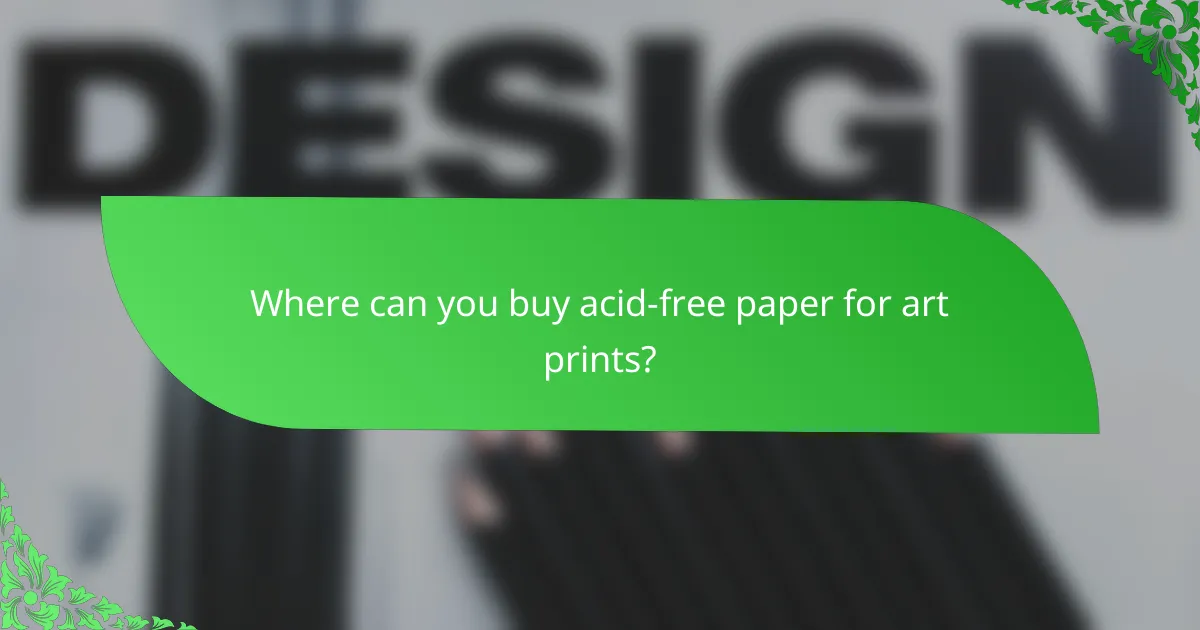
Where can you buy acid-free paper for art prints?
You can purchase acid-free paper for art prints from various sources, including online retailers, specialty art supply stores, and local craft shops. Each option offers unique benefits, such as convenience, variety, and expert advice.
Online retailers like Amazon
Online retailers, particularly Amazon, provide a wide selection of acid-free paper options. You can find various brands, sizes, and weights, often with customer reviews to help inform your decision. Prices typically range from a few dollars for smaller packs to higher amounts for bulk purchases.
When shopping online, consider checking the product specifications to ensure the paper meets archival quality standards. Look for terms like “100% cotton” or “pH neutral” to guarantee longevity for your art prints.
Specialty art supply stores
Specialty art supply stores are excellent places to buy acid-free paper, as they often carry high-quality brands tailored for artists. Staff members can provide recommendations based on your specific needs, whether you’re printing photographs or creating fine art prints.
These stores may offer a variety of textures and finishes, allowing you to choose the best paper for your artwork. Prices can vary, but expect to pay a premium for specialized products.
Local craft shops
Local craft shops often stock acid-free paper suitable for art prints, making them a convenient option for quick purchases. While the selection may be more limited compared to online retailers or specialty stores, you can often find basic options at reasonable prices.
Shopping locally allows you to physically examine the paper before buying, ensuring it meets your quality expectations. Additionally, supporting local businesses can foster community ties and provide personalized service.
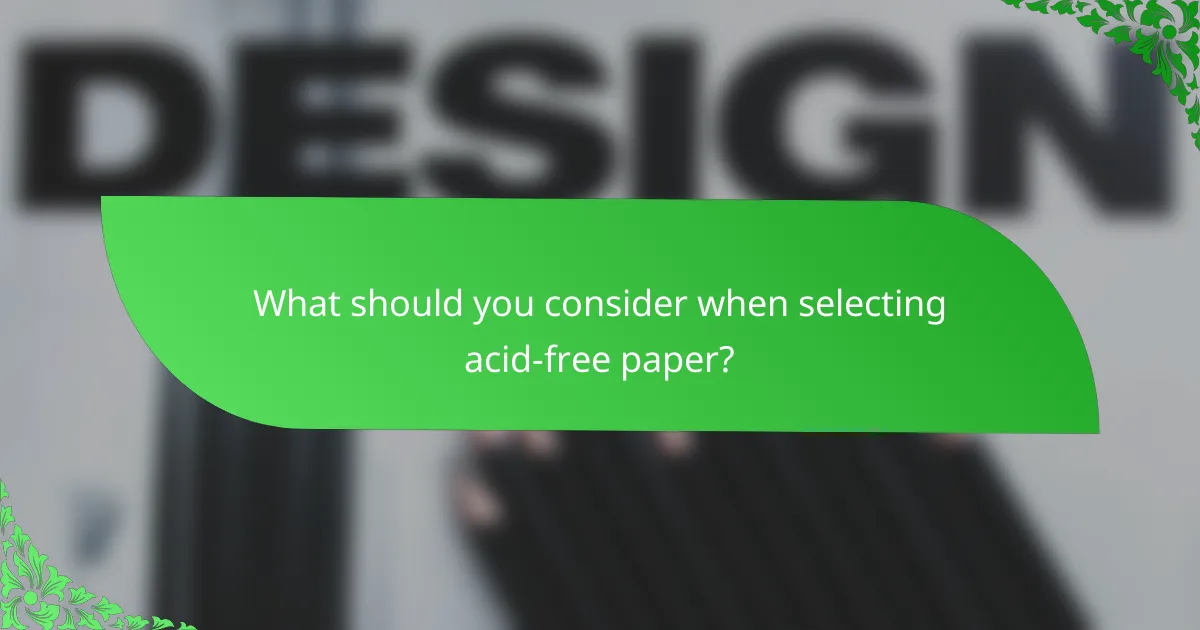
What should you consider when selecting acid-free paper?
When selecting acid-free paper, consider its weight, thickness, texture, and the reputation of the brand. These factors influence the paper’s durability, appearance, and suitability for your specific art prints.
Weight and thickness
The weight and thickness of acid-free paper significantly affect its performance and feel. Generally, heavier paper (around 200-300 gsm) is more durable and can handle various printing techniques without warping. Thinner papers (below 200 gsm) may be more affordable but can be less resilient over time.
For art prints, a weight of 250 gsm is often a good balance between sturdiness and flexibility. Always check the specifications to ensure the paper meets your needs for framing or display.
Texture and finish
Texture and finish play a crucial role in the visual impact of your art prints. Acid-free paper comes in various textures, such as smooth, matte, or textured, each affecting how colors and details appear. A textured finish can add depth, while a smooth finish is ideal for sharp, detailed images.
Consider the type of artwork you are printing. For instance, watercolor prints may benefit from a textured surface, while photographs often look best on smooth, glossy paper. Experimenting with samples can help you find the right match.
Brand reputation and reviews
Choosing a reputable brand for acid-free paper can ensure quality and longevity for your prints. Look for brands that specialize in fine art papers and have positive reviews from artists and photographers. User feedback can provide insights into the paper’s performance in real-world applications.
Check for certifications, such as the ISO 9706 standard for permanence, which indicates the paper’s resistance to aging. Brands with a strong track record in the art community are often a safer choice, ensuring your prints maintain their quality over time.

How does acid-free paper impact the value of art prints?
Acid-free paper significantly enhances the value of art prints by preventing deterioration over time. This type of paper resists yellowing and degradation, ensuring that the artwork maintains its original quality and appeal for longer periods.
Preservation of Artwork Quality
Using acid-free paper helps preserve the vibrancy and integrity of art prints. Unlike regular paper, which can become brittle and discolored due to acid content, acid-free options maintain their color and texture. This preservation is crucial for collectors and artists who want their work to last.
Market Value Considerations
The market value of art prints can be significantly affected by the type of paper used. Art prints on acid-free paper are often more desirable among collectors, as they indicate a commitment to quality and longevity. This can lead to higher resale values and increased interest from potential buyers.
Cost Implications
While acid-free paper may come at a higher initial cost compared to standard paper, the long-term benefits often outweigh this expense. Investing in acid-free materials can save money in the long run by reducing the need for restoration or replacement. For artists and printers, this choice can be a key selling point.
